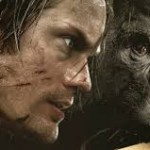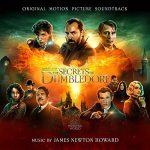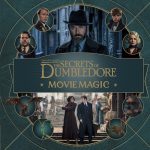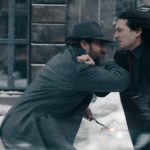David Yates and David Baron talk “Tarzan”

Jul 08, 2016
Films, Movies, News, Yates, Yates Interviews
Harry Potter direct David Yates, and Harry Potter producer David Baron, sat down for a an interview about their most recent collaboration, The Legend of Tarzan. The new live-action take on the classic tale (made famous among younger generations by Disney’s animated feature film) hits theaters this week (already in theaters in the USA)–introducing audiences to Tarzan’s life after he and Jane have married and moved away from the jungle. When trouble arises and new enemies emerge, Tarzan must return to the jungle.
The two Davids sat down with Den of Geek to discuss the film, why they chose the legend of Tarzan, their take on the well-known tale, and more. Den of Geek reports:
Let’s start with something obvious: why Tarzan?
David Yates: Well, I was reading dozens and dozens of scripts, and trying to find something after [Harry] Potter that felt really fun, immersive, and had lots and lots of colours. Potter was a big arena experience, and in terms of storytelling it always had a funny bit, it always had a dramatic bit, always had something that was very emotional, always had something that was very beautifully thematic. It always took you to four or five different places, and as an experience that was always very enjoyable. And I read all these Hollywood scripts that they kept sending me, and none of them did that. They were all very one-note, it was one colour all the way through, whether they were blowing up cities or whatever, and then this script turned up and it said Tarzan on the front, and I said ‘I don’t think I’m going to read that, because I know what that is.’
Then someone who’d read it in my office said ‘I really think you ought to read this, because it’s not what you think.’ Reluctantly, I opened the page, and then I couldn’t stop turning the pages, and there was something about this human being who didn’t really know where home was. He didn’t know if it was in the jungle, or in his country estate in England, and he was stuck between the two, which I found really compelling. And there was something about the themes in the movie, that were beautiful, about reconnecting with the environment, reconnecting with animals, understanding animals, understanding that the environment was being threatened. This old-fashioned, iconic character was somehow connecting with present-day values that were very relevant and very important, and very ‘now.’ But more than anything, it was fun, it was moving, it was romantic, it was exciting, it had all the colours that the Potter movies, for me, would have. I thought ‘fuck, this is the first time I’ve read a script that I really want to go see this movie.’
David Baron: It’s also a very different Tarzan to all the other movies that we’ve seen in the past. For a start, it’s not the story of the foundling in the forest who gets taken back to England by the end, it’s quite the reverse. The character starts in England and goes back to Africa, which is a very refreshing point of view for Tarzan.
That’s something that I’m very curious about. Everything now is an origin story, even things that aren’t really origin stories. Was there pressure to push in? In the clip we saw, there was the beginning of that – was there pressure to make more of that?
DY: There is a bit of origin story in the movie, and there was no pressure from the studio, but when we showed it to the audience, the origins bit that was in there, they loved. When we put a bit more in, they loved it even more, and when we put a bit more in they loved it even more. But the origin story isn’t straightforward origin story, it refracts. There’s a foreground story, and that story of how Jane and Tarzan met, that refracts against the present time. It’s an element. Is it an origin story? Not really.
DB: There’s enough to explain, to people who don’t know the story, it gives them something to hang on to.
DY: It gives you context, and it’s kinda fun.
When he was fighting the monkey, what was he doing really?
DB: You mean physically?
Was it a puppet, or was there a stand-in? How did you do that?
DY: We had a stunt stand-in who would be the gorilla.
DB: In a big suit, for the physical interaction, so Alex’s arms weren’t here, they were sort of here.
DY: Then Alex would fight with him, and then when he couldn’t fight with him because he had to throw a punch, he’d literally be fighting with thin air.
DB: Or a ball on the end of a stick. We didn’t do any motion capture, the apes are completely CG.
DY: You just get the best animators, which we did. And it’s partly about the characters within our story, and you deliver story. Our animals, we made them as photorealistically as we could.
DB: Even though they don’t exist, because they’re giant apes.
They were pretty bloody scary.
DB: They don’t actually exist, they’re drawn from something that was a mixture of a chimpanzee and a gorilla, but they’re bigger. You wouldn’t find anything quite as big as Tarzan’s brother in the wild.
DY: You don’t really look at what other people are doing, you kind of just concentrate on your own story and your own world.
DB: In Planet Of The Apes, they’re pretty much just chimpanzees that ride horses and stand on their back legs.
DY: You look critically at some other work, and you go ‘they did that bit really well, but that bit wasn’t as good.’ You’re aware of it, and you try and learn from other people’s mistakes. And you’ll do something that you think is really good, a stand-out piece of animation, and you do something else and think ‘I’m not sure we nailed that.’
There’s a scene in the trailer where Margot has to scream and she says ‘oh, like a damsel.’ I gather that Jane is quite modern.
DY: She’s feisty. She’s quite modern and feisty, she’s quite punchy.
Where did she punch [Alex], in the face?
DB: No, the arm.
This strategy of finding your own voice, how does it relate to the previous Tarzan movies and what kind of man he is? We know him as being young, and you have to define what kind of man he is becoming.
DY: He’s a man stuck between two worlds. He’s afraid of going back to where he grew up, he’s afraid primarily because he wants to protect Jane, there’s a score that he has to figure out how to settle with an extraordinary character called Chief Mbonga. He actually killed Chief Mbonga’s son at one point in his past, so he’s reticent to go back to Africa. He’s a deeply troubled human being, who is trying to figure everything out, and he has the expectation from his father and his family of staying in England, of keeping the family home, being a proper English lord. He’s quite conflicted. But he finds real peace, and completeness, when he goes back to Africa. He has two families in Africa; he has the Manjani, the gorillas, who found him as a baby, and he has the Kuba tribe, who are this very peaceful group of agrarian tribespeople who saved him and brought him into their community.
DB: Which is where he met Jane.
DY: The Kuba are great, and they bring them into his bigger family. Ultimately, it’s a celebration of family. The thing about Christoph Waltz’s character is, he doesn’t know anything about community, or love, or what it is to feel interconnected, he just wants to take and build for the ambitions of his king. Whereas Tarzan and Jane have this huge family in Africa.
DB: Also Tarzan has, although he didn’t grow up with it, this history of his aristocratic lineage, and Christoph Waltz comes from very humble origins, and thinks that by serving his king well he will be promoted in the annals of history and celebrated as a character who saved his country.
Where does Samuel L. Jackson come into it?
DY: He’s a real character. Sam’s character is based on this extraordinary man, George Washington Williams, a preacher-lawyer-soldier, and one of the first people to draw people’s attention to what was happening in the Congo. There’s a level of politics in the movie, with a very small P, we didn’t want to dwell on it too much but it does give context for what’s happening in our story. So George Washington Williams, played by Sam, wants to try and get to the bottom of what King Leopold is up to in the Congo, which is basically enslaving a good portion of the population. So Sam persuades John, Tarzan, to take him back to the Congo, where they can work together to uncover what Leopold’s up to.
DB: Which was genocide on a massive scale.
DY: It was the first great genocide. Actually, that’s a really heavy part of it, and if one percent of the audience gets intrigued by that, they can learn about the first great genocide.
Will we be hearing the famous Tarzan yell?
DB: Of course you will!
DY: We were mixing it this morning.
To read more of this extensive interview with David Yates and David Baren, learn more about the animation of the film, casting choices, and how Jane saves Tarzan, read here.





